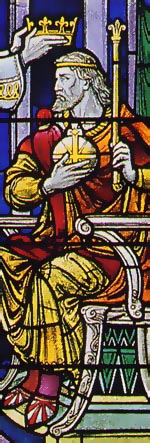 |
 |
|||
|
|
King Edgar was the youngest child of King Edmund the Magnificent and St. Aelfgitha. As a boy, he was fostered by Athelstan Half-King, the Ealdorman of East Anglia, and his wife, Aelfwin. The family were keen supporters of monastic reform and Edgar's education was therefore placed in the hands of the movement's mastermind, St. Aethelwold, at his abbey in Abingdon. In AD 955, Edgar's uncle, King Edred, died and his elder brother, the fourteen year old Edwig, became King. However, when Edgar reached the same age two years later, the kingdom was divided and he was given the Northern regions of Mercia and Northumbria, while Edwig retained Wessex. Edgar immediately recalled his uncle's advisor, St. Dunstan, from exile and made him Bishop of Worcester, before his transfer to London. Edwig died in AD 959 and Edgar became King of all England. Dunstan was appointed Archbishop of Canterbury and Edgar naturally associated himself with the prelate's extension of monastic reforms. The establishment of English Benedictine monasteries across the country became the central policy of Edgar's reign. Though hugely successful, it was not universally popular. Vast areas of land were arbitrarily put under Church control, provoking considerable resentment which was to destabilize his son's reign. Though a good king, Edgar was not overly religious. His sexual appetite was legendary and gave rise to a number of stories. Soon after ascending the throne, he is said to have fallen for the beautiful daughter of a nobleman of Andover (Hampshire). While visiting the town, he demanded that she enter his bed that night. Her parents were, understandably, shocked and sent a maidservant to join the King in her place. After a long night of unbridled passion, Edgar was disappointed to find that his new conquest hurried from his bed early the next morning. The deception was thus revealed, as the girl explained that she must start work before the rest of the household arose. In a mad fury, the King confiscated all his hosts' lands and made his bed-fellow their mistress. About AD 960, he married Ethelflaeda Eneda (White-Duck), the daughter of a Hertfordshire nobleman named Ordmaer. She seems to have been some relation of Edgar's foster-father, Athelstan of East Anglia. They had one son, Edward, before the lady died, around AD 963. During this marriage, the King was by no means monogamous and seduced a young nun, named Wulfthrith, from Wilton Abbey (Wiltshire), carrying her off to Kemsing in Kent where their extended affair led to the birth of a daughter. The following year, Edgar heard of another great beauty, Aelfthrith the daughter of the Devonshire Thegn, Ordgar. He sent his foster-brother, Ealdorman Aethelwold of East Anglia to check her out; but the young man found her so stunning that he secretly married and settled in distant Devon. Hearing that his foster-brother had married, but not to whom, the King insisted they visit him at Court. Discovering Aethelwold's duplicitous nature, Edgar took him out hunting in Harewood Forest (Hampshire) and thrust a javelin through his back! After Ethelflaeda's death, Edgar tried to persuade his lover, Wulfthrith, to marry him but the relationship seems to have been somewhat one-sided and she fled back to the safety of the confines of Wilton. He turned to Aethelwold's widow instead and the two were married in AD 964. Though Edgar had almost certainly been crowned King of Wessex at Kingston-upon-Thames, early in his reign, by AD 973, he wished to mark a new stage in the development of Anglo-Saxon kingship with a great coronation ceremony on the Mercian-Wessex border at Bath. In this ancient Imperial city, he was officially declared King of the English. Then he showed his extensive and effective military power, by marching his army north - swelled with Viking warriors - in a great show of strength. His navy joined him in Chester where the kings of the north assembled to submit to his overlordship: King Kenneth of Scots, King Malcolm of the Cumbrians, King Magnus of Man and the Isles, King Donald of Strathclyde, Joint-King Hywel of Gwynedd, Joint-King Iago of Gwynedd, King Idwallon of Morgannwg and King Siferth. According to tradition, originating with Florence of Worcester, they rowed King Edgar up River Dee, from the Royal palace to the monastery of St. John the Baptist. King Edgar died on 8th July AD 975 and was buried St. Dunstan's abbey at Glastonbury (Somerset) where he was reverred as a saint, presumably for his monastic reforms and the stability he brought to the country, rather than his sexual conquests!
|
|||
| © Nash Ford Publishing 2001. All Rights Reserved. | ||||



 St.
Edgar the Peacemaker (AD 943-975)
St.
Edgar the Peacemaker (AD 943-975)